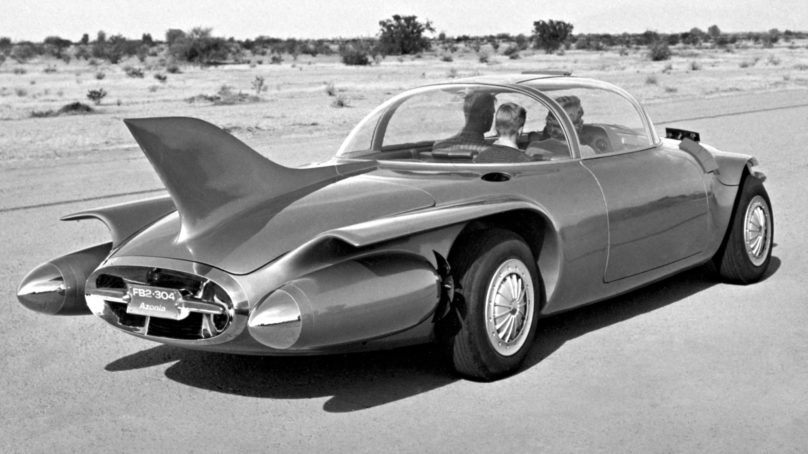
From 1949 to 1961, General Motors staged a series of shows which spotlighted their products from each of their varied divisions for a total of eight times. Those from 1953 to 1956 are the most remembered since those had a variety of what were then known as “dream cars.” Today, we refer to them as concept cars. The dream cars were the drawing card for the millions of people who ventured to the General Motors Motorama, an admission-free, extravagant auto show held in major cities across the United States. General Motors of Canada also sponsored a nearly identical version in major cities in Canada, but utilizing some of what were then one-year old dream cars, for the shows held there from 1954 through 1957.
Among the many dream cars produced for the auto show circuit were a series of experimental types which went beyond the typical concept cars; they were serious, advanced research cars powered by an alternative to GM’s straight-six and ohv V-8s of the day—the turbine engine. These cars were known as the Firebird I, Firebird II, and Firebird III.
A brief revival of the GM Motorama took place for the 1959 model year in which the 1958 GM Firebird III was exhibited. It was also shown at many other venues including the GM of Canada Motorama. By this time period, the construction of new dream cars was greatly reduced for multiple reasons, discussion of which is beyond the purpose of our story.
Turbine Research Begins at GM
Soon after jet engines began to enter into general use in military aircraft after the end of World War II, the idea of adapting the technology for automotive use began to be explored. The British had already built and tested the world’s first turbine-powered car, the Rover J.E.T., shortly before the emergence of the GM Firebird.
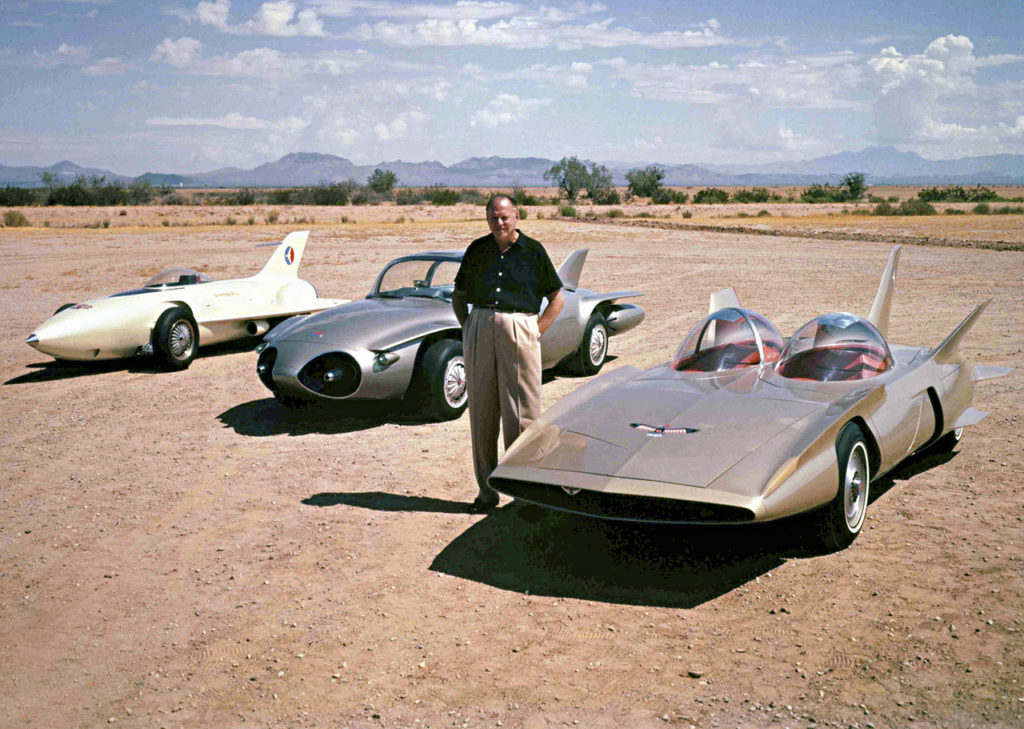
Harley Earl, the vice president of GM Design posed with the Firebirds for this photograph taken in 1958, at GM’s Mesa, AZ proving grounds. Earl retired from GM at the end of the year. He established GM’s styling department in 1927. (GM Media Archive)
The first of the GM turbine cars was the 1953 GM Firebird, which was also known as the XP-21 Firebird. (XP-21 was its internal designation prior to a formal name being chosen.) Later, it was relabeled as the Firebird I after its successor the Firebird II was built. It resembled a jet-powered fighter plane, and indeed, its styling was largely influenced by the shape of the delta-winged F4D Skyray interceptor flown by the U.S. Navy. GM’s styling boss, Harley Earl, explained the origin of the Firebird’s design in an article he authored for the Saturday Evening Post titled, “I Dream Automobiles.” He wrote, “The Firebird tickles me because of its origin. In our 1953 Motorama the spotlight model of the dream cars was the Le Sabre, and just after it had been first shown to company officials, I was on an airplane trip. I picked up a magazine and noticed a picture of a new jet plane, the Douglas Skyray. It was a striking ship, and I liked it so well that I tore out the picture and put it into my inside coat pocket. Subsequently a traveling companion, also a GM officer, stopped at my seat to congratulate me on Le Sabre. ‘But,’ he added, ‘now what will you do for next year?’ At that moment, I had absolutely nothing in mind. But I patted the pocket where the picture of the Skyray was tucked away. ‘I have it right here,’ I said. I was joking. I was merely answering his banter in kind. Then, bingo, I decided I had kidded myself into something. The result, as you may have seen, is that the Firebird is an earth-bound replica of the Skyray airplane.”
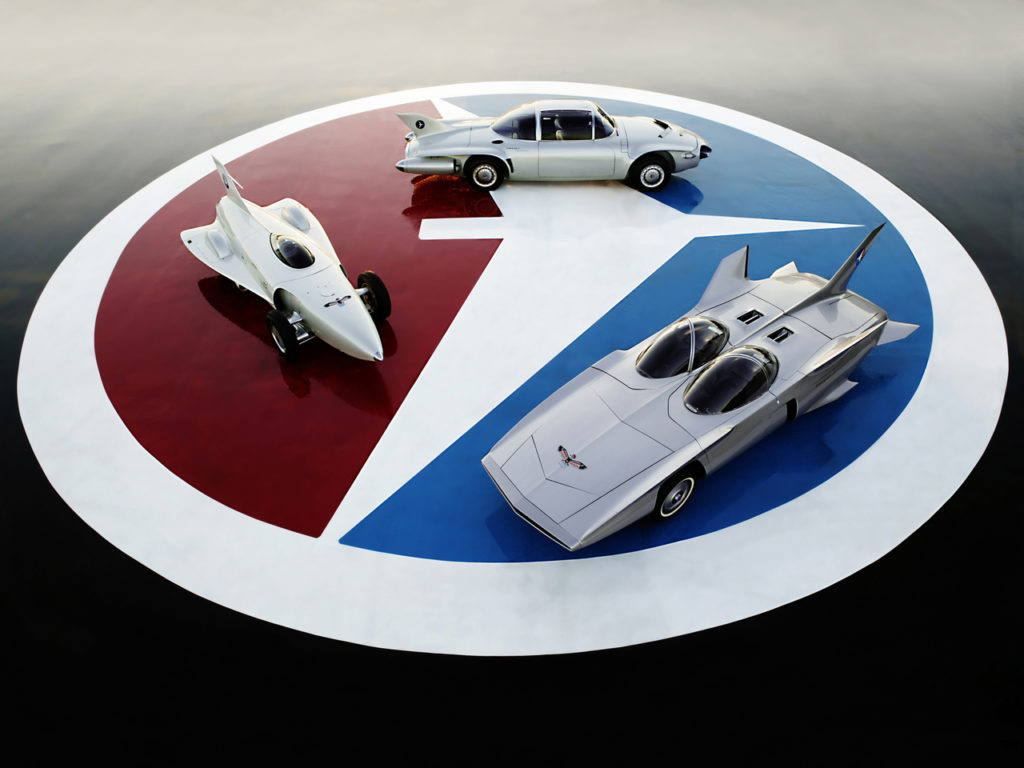
The Firebirds are part of the collection of the GM Heritage Center and continue to be shown at various auto shows and museums across the country. (GM Media Archive)
The radical airplane-like styling for the Firebird was not simply about getting noticed; it served to underscore the fact that a turbine engine—basically an aircraft jet engine—powered it. Furthermore, its unconventional appearance was intended to imply that practical turbine engines for automobiles were considered to be years away, at best, from being used for production automobiles. The original Firebird was also expected to provide an opportunity to test the little understood area of aerodynamics for land vehicles. A near exact, scale model of the research car was sent to the California Institute of Technology for extensive wind tunnel testing to establish the best shape for the Firebird’s body as well as determine the optimal brake flap angles and the amount of negative angle of attack for the wings.
In 1953, turbine engine research with the GT-300 had been underway at the GM Research Laboratories Division for several years. A turbine engine was originally expected to be tested for use in heavy-duty trucks and buses, but then Harley Earl thought an automobile should be used as the research medium. Simply put, the Firebird was a research vehicle to help determine whether or not a turbine engine could be used to provide economical and satisfactory performance in an automotive application.
The Firebird I’s more advanced GT-302 Whirlfire Turbo-Power engine and its chassis design were the responsibility of the GM Vice President and General Manager of GM Research Laboratories Division, Charles McCuen, and William Turunen who had delved deeply into the potential of the turbine engine for automotive use. Bob McLean, a Cal Tech graduate who had an aeronautical background, was placed in charge of the Firebird’s overall design.
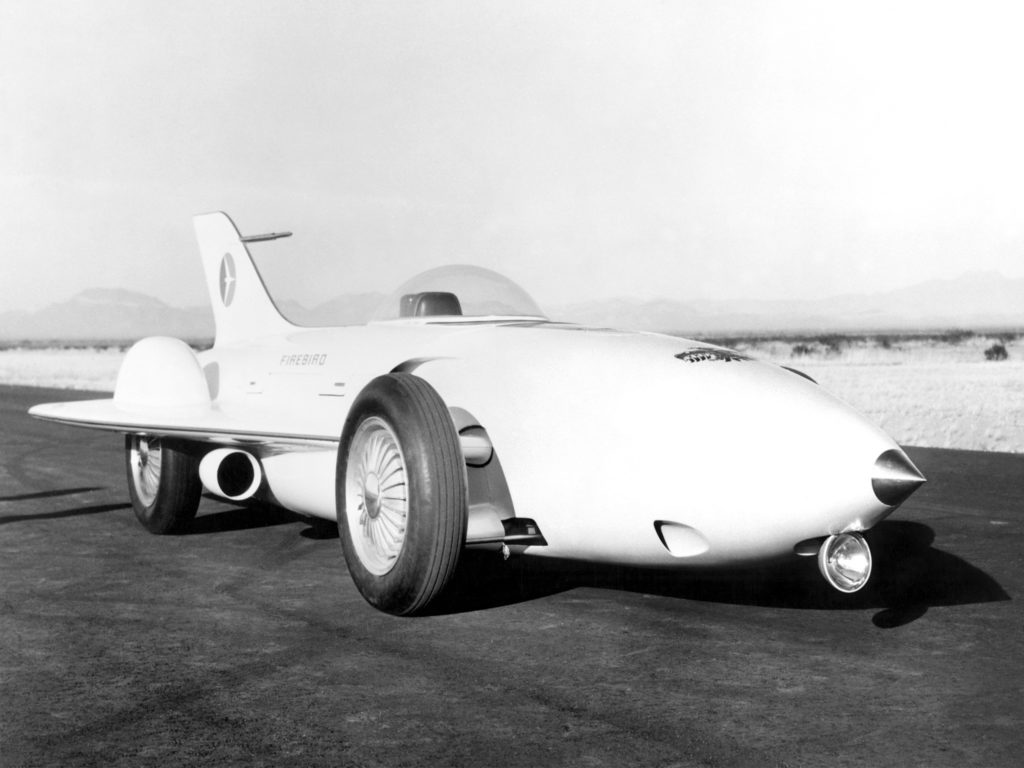
The Firebird I had a single deployable headlight. (GM Media Archive)
The nose of the Firebird contained a 35-gallon fiberglass fuel tank and just behind the cockpit sat the two-part gas turbine engine consisting of the gasifier and power sections connected by a flexible shaft. The gasifier section was analogous to the engine and torque converter pump of a conventional automobile and the power section substituted for the torque converter turbine, transmission, and rear axle gears. Unlike a jet engine which propels an aircraft by the expulsion of the exhaust, the turbine engine of the Firebird had to have its exhaust gases funneled through a power turbine connected directly to the car’s rear wheels via a transmission. The gasifier section was composed of the compressor rotor and a gasifier turbine wheel each attached to a common shaft. Air entering the compressor was pressurized to 3 ½ times atmospheric pressure (14.7psi at sea level) prior to entering the two combustion chambers where the gas temperature soared to 1,500 degrees Fahrenheit. The hot gas blasting from the gasifier turbine ran the second turbine—the power section turbine—connected to the Firebird’s rear wheels through a two-speed planetary transmission.
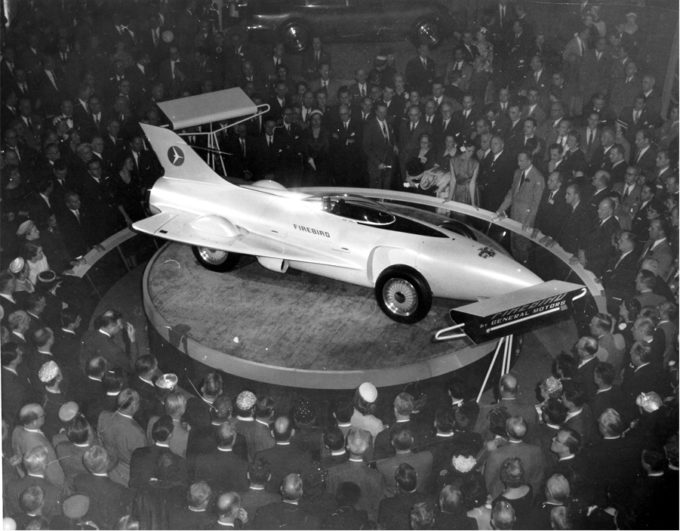
The 1953 Firebird I was shown at the 1954 GM Motorama show circuit. This photo was taken at the Waldorf-Astoria’s grand ballroom in January of that year. (GM Media Archive)
The GT-302 which idled at 8,000rpm was rated at 370hp at 26,000 revolutions per minute of the gasifier turbine and 13,000rpm of the power turbine—well beyond the RPMs of an automobile gasoline engine, but actually relatively low revs for a turbine engine. Its lower rotational speed reduced the stresses imposed on the moving parts, thus increasing reliability. Even so, the stresses applied were plenty high; a gasifier turbine blade tip speed could be as high as 1,000mph, placing a 3,000-pound pull on each light-weight blade. The 775-pound weight of the GT-302 turbine engine accounted for 31% of the Firebird’s total weight of 2,500 pounds. These numbers implied a theoretical top speed of over 200mph!
The suspension system of the Firebird was composed of a double wishbone and torsion bars in front while the rear received a DeDion type. Split brake flaps on the trailing edges of the wings controlled with switches on the steering wheel activating aircraft-type actuators helped to slow the Firebird from higher speeds. Eleven-inch diameter brake drums were mounted outside the wheels rather than inside them to help dissipate the heat generated from braking. Furthermore, a total of 16 gauges provided important performance data to the driver of the Firebird.
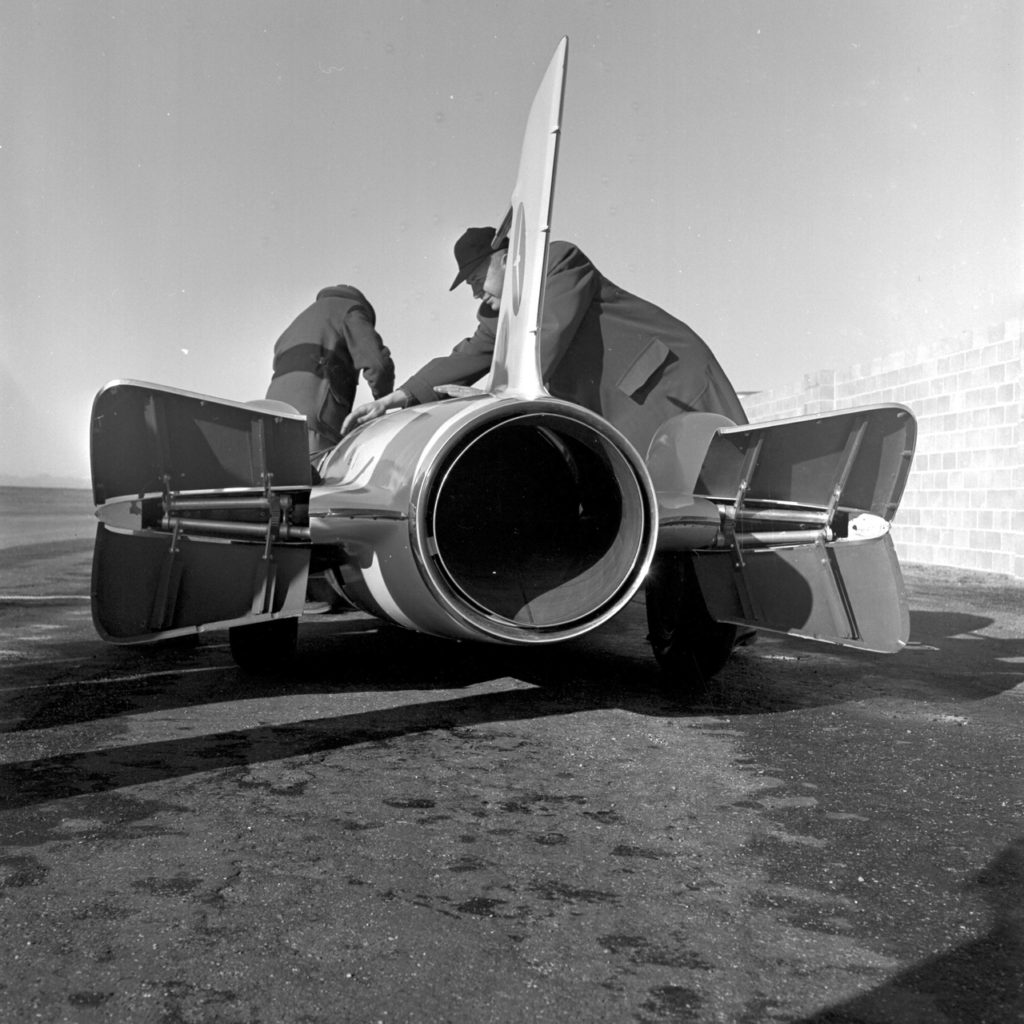
This aft view of the Firebird I shows it with its speed brakes in the deployed position. The GT-302 Whirlfire turbine engine powered it. Split brake flaps on the trailing edges of its “wings” controlled with switches on the steering wheel activating aircraft-type actuators also helped to slow the Firebird from higher speeds. (GM Media Archive)
Three-time Indy 500 winner and engineer Mauri Rose was a consultant to GM. One of his assignments was to evaluate the performance of their Firebird at GM’s test track in Mesa, Arizona. Engineers expected the car would easily surpass the record set by the experimental Rover J.E.T. However, before Rose could put the Firebird through high-speed runs, Charles McCuen decided to perform some tests himself and almost got killed in the process. The Firebird accelerated slowly, but once its turbine engine reached high rpm it began to accelerate quickly. As McCuen approached the far turn in the test track, the Firebird was accelerating at a high rate; letting off the accelerator did virtually nothing to slow the speeding car because the turbine engine did not provide engine braking as in a conventional automotive engine. There was very little time to apply the brakes either. The car skidded underneath the 41-inch high guard rail and tumbled several times. McCuen survived only because of the Firebird’s built-in headrest and safety harness. He recovered just enough from his injuries to return to work for a while, but then took an early retirement at age 63 in 1955 and lived another 20 years. The fiberglass-bodied Firebird was repaired in time for the opening of the 1954 GM Motorama at the Waldorf-Astoria.
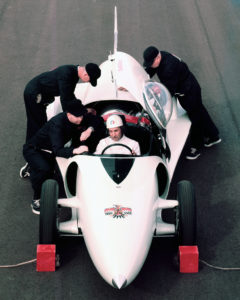
Three-time Indy champion Mauri Rose was hired by GM as a consultant. He tested the 1953 Firebird I at the company’s proving grounds in Mesa, AZ. Note the swing-open canopy. It could be opened from either side or completely detached. (GM Media Archive)
Though Mauri Rose did test drive the GM Firebird I, high-speed trials were not attempted again, thus leaving the true top speed as only an educated guess. In a report written by Rose for the April 1954 Motor Life, he stated “… the steering was absolutely true. The car wanted to behave. It wanted to keep going straight ahead. It was perfectly stable.” He also said with a note of strong conviction that, “With absolute sincerity I can say that the car itself is an outstanding job from both styling and engineering standpoints.”
The original Firebird had some deficiencies—not at all surprising with a new, advanced project. It was somewhat noisy, had poor fuel mileage, and the exhaust temperature was very high at roughly 1,000 degrees Fahrenheit. These problems would be mitigated with the next Firebird turbine car.
1956 GM Firebird II
General Motors built upon the lessons learned with the Firebird I when they designed their next turbine-powered research car—two of which were built—the 1956 Firebird II (XP-43). It was “the first American gas turbine passenger car specifically designed for family use on the highway,” according to a GM-issued press release. (Their claim was technically correct. Chrysler Corporation tested a turbine engine in a nearly stock 1954 Plymouth Belvedere, a car adapted for a turbine engine rather than designed from the start for turbine power.) However, the new Firebird II went far beyond the aircraft-like Firebird I. It was used to test experimental suspension and braking systems, too. The Firebird II also pioneered the concept of futuristic electronic highways in which cars of the future might be controlled electronically for speed, direction, and spacing interval in order to eliminate driver error in the operation of an automobile. Today the concept has reemerged as the self-driving car.
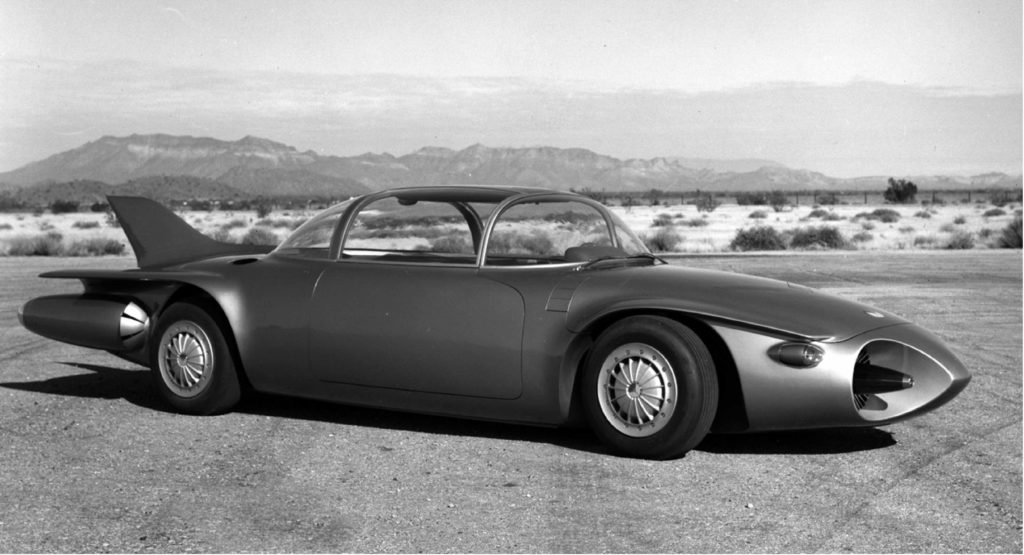
This photograph of the 1956 Firebird II (functional version) was photographed at GM’s proving grounds in Mesa, AZ, where the “Highway of Tomorrow” concept was tested. The FB II was equipped with air conditioning much to the relief of anyone sitting underneath the experimental car’s canopy! (GM Media Archive)
Another innovation tested with just one of the Firebird IIs was titanium as a potential alternative for body construction. This one was nonfunctional and was used as the display car for the 1956 GM Motorama. The other one, built with a fiberglass body, served as the actual research vehicle.
Dr. Lawrence Hafstad, the vice president of the GM Research Laboratories staff, was assigned to lead the engineering team in charge of designing the engine and chassis of the Firebird II. Among the advances made with this experimental car over the previous one include its GT-304 Whirlfire which had a more efficient regenerator which recycled 80% of the exhaust heat wasted in the GT-302 of the Firebird I. As a result, fuel economy improved to almost that of the average piston engine of the day. Another was lower temperature exhaust gases, which traveled through a set of stainless steel pipes running through the rocker panels and onward to ports on top of the rear fenders; exhaust temperature was reduced to nearly the same as any other automobile. Noise was also reduced to nearly that of a conventional car through the use of a silencer built into the nose of the Firebird II. The GT-304 was a less powerful engine – only about half as much at 200 gross horsepower at 28,000rpm—and it had to carry more than double the weight as its predecessor. As a test bed for a turbine-powered family car, it also lacked the sleekness of the first Firebird, too.
Other Ideas Tested on the Firebird II
Other advanced features tested on the Firebird II involved its starting procedure, highway of tomorrow control systems, air conditioning, chassis, and braking systems.
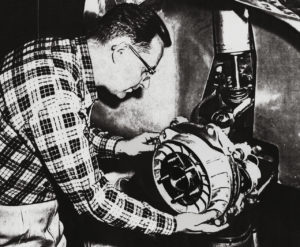
GM’s Moraine Products Division designed the experimental all-metal “Turbo-X” brakes for the Firebird II. It was composed of cast-iron disks rotating with the car’s wheels and a set of metal-lined pads. Applying the hydraulic brakes squeezed the disk between a movable pad on the inboard side and a fixed pad on the outboard side. (Author’s collection)
Starting the Firebird II’s turbine engine was done by inserting a magnetic key and depressing the starter button. A Delco-Remy motor then brought the gasifier section up to 4,000rpm, enough to make ignition automatic. The starter then continued to assist up to 15,000rpm.
Design for Dreaming, a movie shown at the 1956 GM Motorama to explain the concept of automatically controlled highways of the future, included a scene of a family enjoying a vacation drive during a contemporary setting, but soon they encounter a frustratingly congested highway and begin to dream of what might be 20 years later in the year 1976. In their dream, the family was traveling in a Firebird II on the radar-controlled highway of tomorrow free of traffic jams. Presented was the idea that such convenience would be possible with a flip of a switch to activate an automatic control system allowing electronic impulse-emitting metal strips embedded in the road surface to communicate with electronic pick-up coils placed inside the pair of cone-like projections on the front of the Firebird II. Electronic signals controlled steering, speed, and braking through the car’s onboard computer which freed the occupants to talk, play games, watch television, or to just watch the scenery. Occupants could communicate with control towers along the “Auto-Way” to obtain directions, find motel vacancies, make reservations, or get other information while the control tower operator who could communicate with passengers by flashing messages on the two TV screens in the car, or through voice communication. As soon as the driver entered the roadway the control tower operator could check the fuel level and engine operation of the car and synchronize speed and direction while the driver manually positioned the car over the metal strips. If anything was found to be amiss with the vehicle at any time along the way, the car could be guided automatically to a safe place out of traffic.
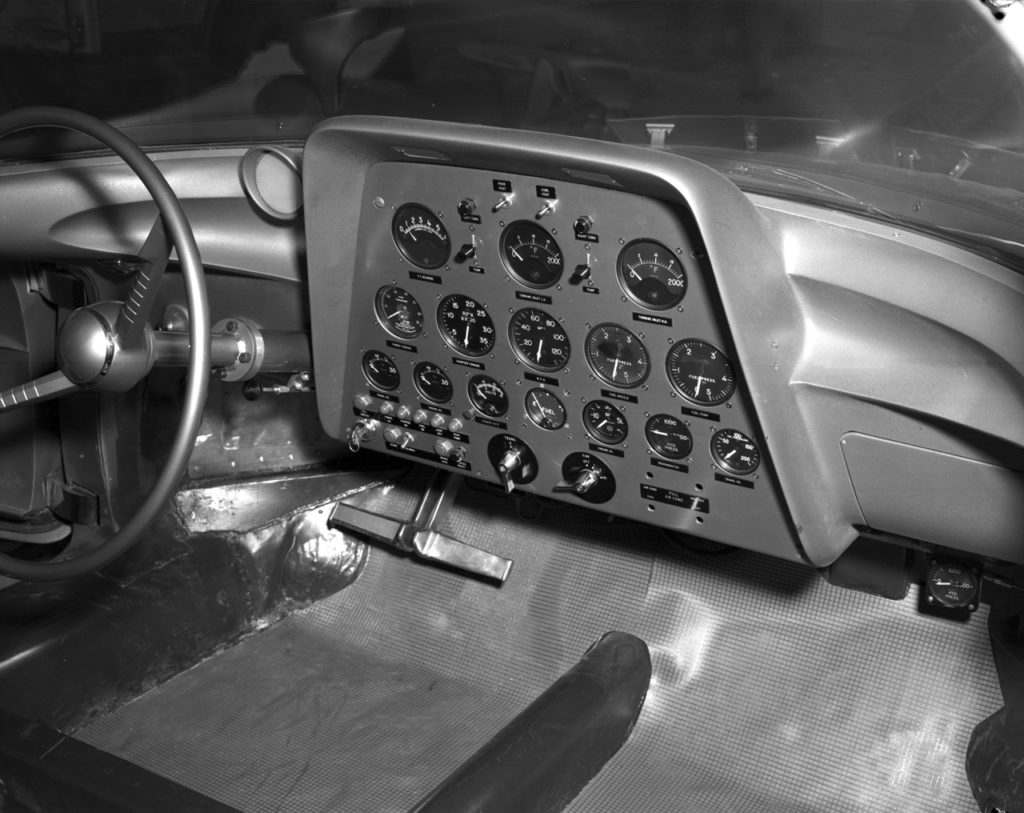
The functional Firebird II was equipped with many gauges to monitor the performance of its various systems. They informed the driver of data such as the temperature of critical bearings, turbine inlet temperature, gasifier rpm, fuel nozzle pressure, fuel pump pressure, regenerator hydraulic pressure, etc. (GM Media Archive)
The “highway of tomorrow” systems of the Firebird II were only simulated on the car for a time. About two years after the 1956 GM Motorama, functional systems were installed on the road test car and successfully demonstrated to the press by GM engineers.
The sloping nose of the Firebird II contained a set of oil cooling fins located immediately behind the electronic sensors in the cone-like projections all fitted in deep recesses. Behind this equipment were what looked like turbine blades which severed to prevent larger objects from getting into the engine air inlet. The experimental car’s small headlights retracted into the body when turned off, leaving only the turn signal/parking lamps exposed. When the headlights were turned on, they extended outward several inches and emitted a strong beam of light. A set of flaps in front opened automatically to allow heat to escape. Also in back were two 10-gallon fuel pods over which the rear fenders flared outward. Taillights appeared to be absent in daylight as they were housed in a large reflector that created a chromed effect; however, they had the appearance of a glowing jet exhaust pipe at night. The entire trunk floor rose like a freight elevator to fender height to eliminate the need to lean over for access to the trunk. Inside the trunk were eight pieces of fitted luggage as well as twin, 12-volt batteries.
The frame of the running car had to be built rigidly enough to prevent the clear, bubble-like canopy from cracking. Flip-up panels on the canopy opened when the magnetic key was inserted into a slot on the car’s body side panels to ease ingress and egress from the car. The functional Firebird II was also equipped with air conditioning and a heater. Air conditioning was vital because the bubble canopy created a greenhouse effect. It was especially needed when the highway of tomorrow systems were tested at the Mesa, Arizona proving grounds. Also a set of three flaps in the center of the canopy could be opened to cool the interior.
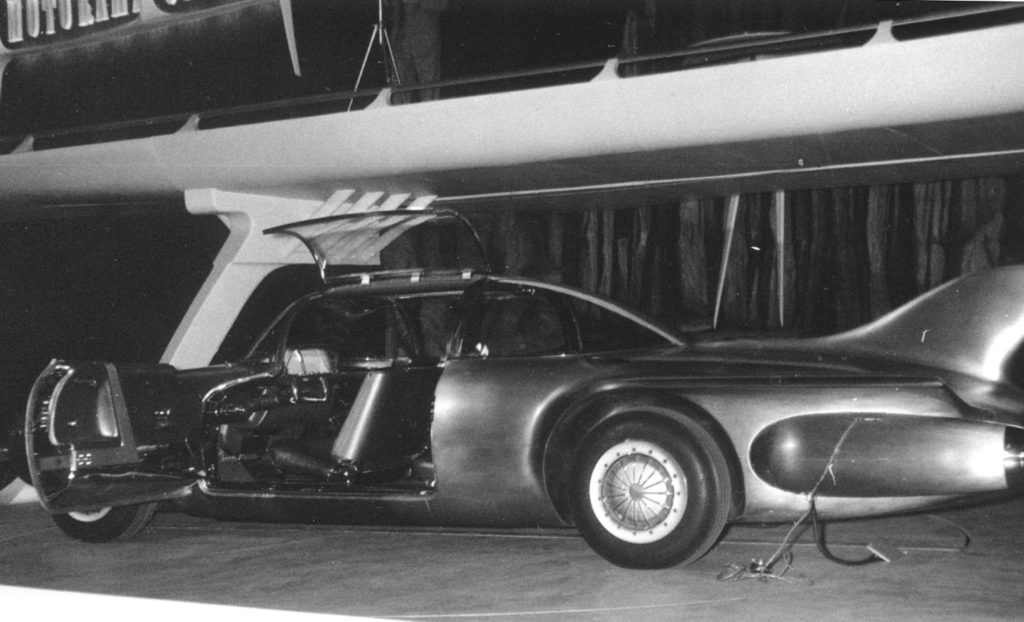
The non-functional Firebird II with its body made of titanium was shown on the 1956 GM Motorama show circuit as well as other auto show venues throughout the 1950s. This photo is believed to have been taken at the GM Motorama held at the Pan Pacific Auditorium in Los Angeles. (Author’s collection)
An experimental air-oil suspension system designed by the Delco Division was installed in the road test car. The Delco-Matic air-oil suspension units replaced conventional shock absorbers and springs. A cushion of air provided soft springing and a hydraulic leveling system compensated for light or heavy loads to keep the car level. According to GM, the Firebird II was the first American car to have leveling in both the front and rear. When the car was moving, the leveling system switched off and provided a smooth ride with air cushioning.
The Moraine Products Division designed the experimental all-metal “Turbo-X” brakes for the Firebird II. It was composed of cast-iron disks rotating with the car’s wheels and a set of metal-lined pads. Applying the hydraulic brakes squeezed the disk between a movable pad on the inboard side and a fixed pad on the outboard side.
The More Advanced Firebird III
Turbine engine research moved ahead with the 1958 Firebird III (XP-73). It proved to be the last of its kind, though for 1964 GM trotted out the Firebird IV which was said to be turbine-powered. In fact, it was a non-functional show car without an engine.
According to GM’s booklet, Flight of the Firebirds, Harley Earl “envisioned an entirely different type of car, ‘which a person may drive to the launching site of a rocket to the moon,” when he considered the styling for the next turbine car. For the times, the styling which included a twin-bubble canopy and multiple tail fins certainly fit Earl’s vision.
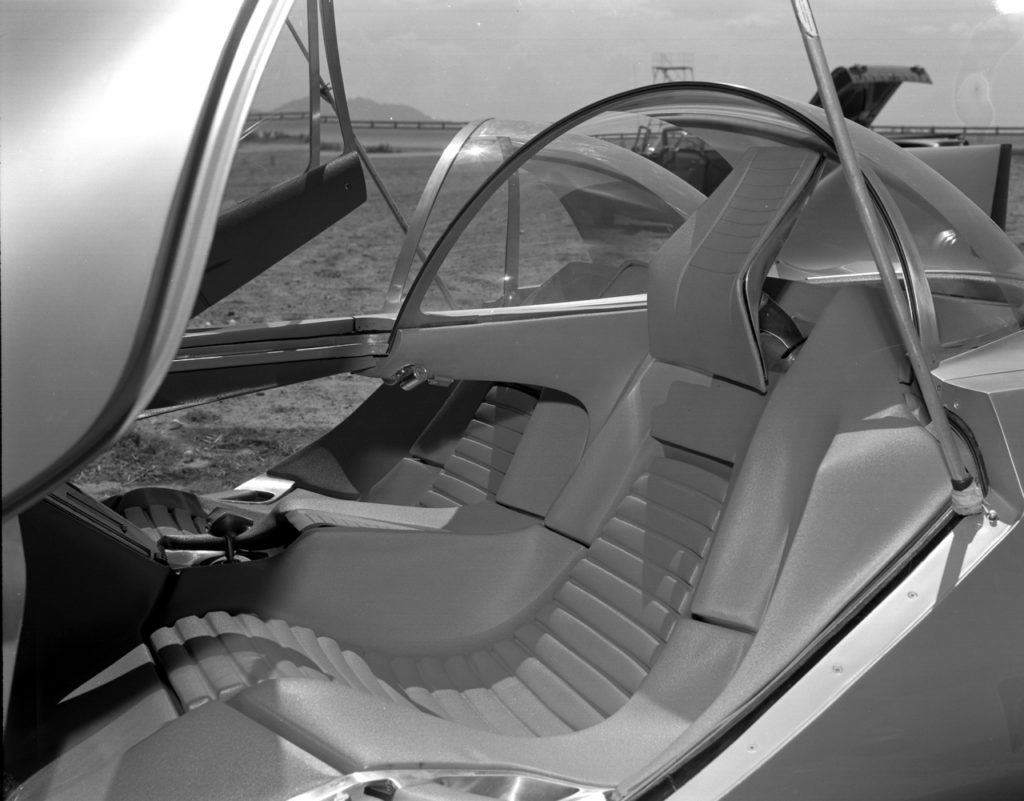
Access to the interior of the Firebird III was via an ultrasonic key. Just pointing the ultrasonic key at the door caused it to swing upward and forward; the side panel and bubble canopy were joined as one unit to form the door. A booklet detailing the FB III pointed out that one could step into the car without stooping and be seated in a comfortable lounge-chair seat. The upholstery was originally red, but was changed to black sometime later. (GM Media Archive)
Contained within the car’s fiberglass body were a regenerative gas turbine GT-305 and a separate two-cylinder, ten-horsepower aluminum engine to run the electrical and hydraulic accessories consisting of steering, braking pumps, brake flaps, air suspension, and air conditioning systems. The new engine was 25% lighter, more compact, developed 225 horsepower at 33,000rpm gasifier speed, and provided a 25 percent increase in fuel economy compared to the GT-304. The engine, transmission, and differential were mounted as a unit behind the passenger compartment. Its trans-axle included a Hydra-Matic transmission mounted directly to the differential case.
Building upon the highway of tomorrow research done with the Firebird II, this car received a revised system called “Autoguide.” Other advanced gadgetry of the Firebird III included a functional “Cruisecontrol” to automatically maintain a constant speed as well as a “Unicontrol” system for driver control of steering, acceleration, and braking. It was operated with a swivel stick accessible from either seat. Moving it engaged servos controlled by three analog computers which compensated for too much driver input such as a sudden turn at high speed. Pushing it left or right steered the Firebird III; a forward push or a backward push caused the car to accelerate or brake, respectively. Rotating the handle 20 degrees in either direction engaged reverse and an 80-degree rotation in either direction engaged “park.”
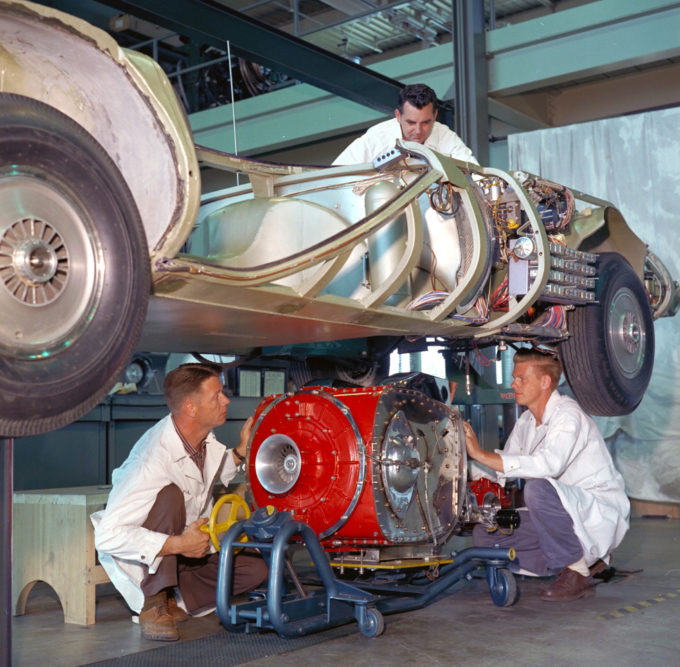
The GT-305 was installed in the Firebird III from underneath the experimental car. (GM Media Archive)
In GM’s booklet, Imagination in Motion—Firebird III, the aspects of research being done with the car was encapsulated by the phrase “human engineering” and was explained this way: “Automotive engineers have long recognized an area of development known as human engineering… In this car, the driver has been viewed as a challenge rather than as a limitation to automotive engineering possibilities. Here is an opportunity to use new simplified control devices, to provide improved air-conditioned comfort, and the armchair ride of an entirely new high-pressure air-oil hydraulic suspension system.” The Firebird III was the first completely electronically controlled car.
Yet another area of research conducted with the Firebird III was an anti-lock braking system. Though such systems are commonplace, it was quite hi-tech for the day. The 11×4-inch “Turb-Al” brake drums were cast into the alloy wheels and faced with iron. Brake shoes were composed of sintered metallic linings. Cast-in cooling passages between the drum and wheel brought cooling air in through the hub and spun out through the slots. At speeds above 30mph, the airbrake flaps were deployed to aid in braking. Additionally, a “grade retarder” using oil-cooled friction discs on the rear axle shafts also went into action above this speed.
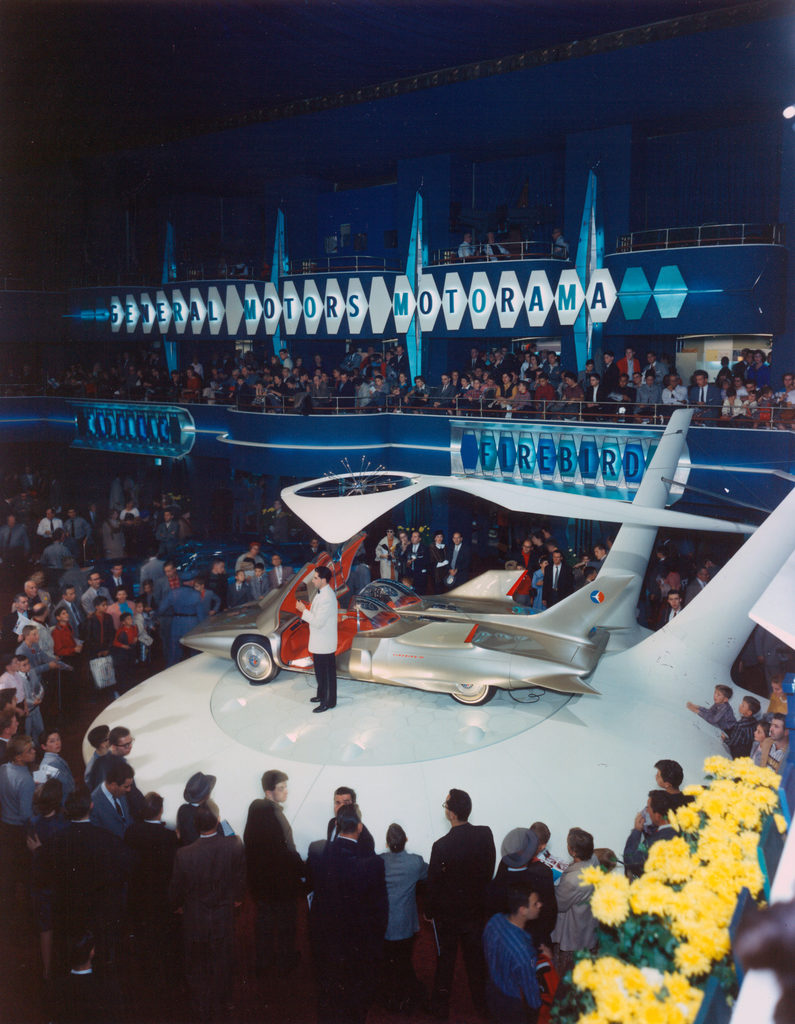
The 1958 GM Firebird III was the only concept car on exhibit at the 1959 and 1961 GM Motorama. This photo was taken at the 1959 show at the Waldorf-Astoria when the car was painted “Lunar Sand.” (GM Media Archive)
The Firebird III’s experimental suspension system was composed of solid axles anchored to the sub-frame with four control arms on each, which reduced the car’s overall height and kept the wheels perpendicular to the road at all times to improve handling. Its air-oil springs at the front and rear were interconnected so as to cause vertical forces acting on a front wheel to be simultaneously applied to the rear wheel in order to suppress pitching motions for a smoother ride. The car’s air-oil unit operating at 3,000psi had a variable spring constant which gave a strong spring action when the car was heavily loaded and a relatively weak spring action when lightly loaded. Height control valves maintained a fixed road clearance, regardless of the load carried (within design limits of course).
Turbine research continued at GM with a series of heavy-duty trucks during the 1960s, but this alternative power system has yet to enter production for any automobile even in the 21st century. However, it got close in the 1960s. Chrysler Corporation also performed research on the use of turbines for automotive use. At one point they planned to produce and sell 500 turbine-powered Dodges for the 1966 model year, but the plan was halted due to the issuance of new regulations by the federal government regarding emissions from automobiles. Chrysler worked on that problem for some time, but when facing bankruptcy around 1980, their research ended.
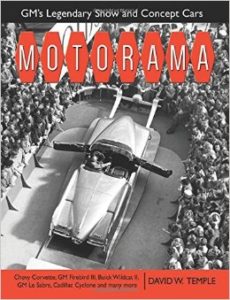 David W. Temple is a freelance automotive photojournalist specializing in vintage cars. His work has appeared in Auto Restorer, Car Collector, Cars & Parts, Collectible Automobile, and many others over the past 30 years. Temple has also authored four books including Full Size Fords: 1955-1970 and The Cars of Harley Earl and at the time of publication of this story is authoring Chevrolets of the Fifties. Much of this story was excerpted from the author’s book, Motorama: GM’s Legendary Show and Concept Cars.
David W. Temple is a freelance automotive photojournalist specializing in vintage cars. His work has appeared in Auto Restorer, Car Collector, Cars & Parts, Collectible Automobile, and many others over the past 30 years. Temple has also authored four books including Full Size Fords: 1955-1970 and The Cars of Harley Earl and at the time of publication of this story is authoring Chevrolets of the Fifties. Much of this story was excerpted from the author’s book, Motorama: GM’s Legendary Show and Concept Cars.



